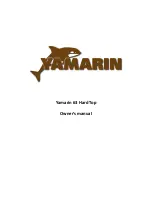
2-17
190 Montauk
Section 2 • General Information
R
210 Montauk
The power trim & tilt system
located on the shift control
lever (Fig. 2.18.1) allows
you to raise and lower the
engine to achieve optimum
performance and is used for
trailering, launching and beaching.
Ensure continuous visibility of other boats,
swimmers and obstacles during bow-up
transition to planing. Adjust engine to an
intermediate trim as soon as boat is on plane.
ATTENTION
Power Trim & Tilt
DN
UP
TRANSFE
R
DOCK
START
STOP
THROTTLE ON
LY
N
Throttle/Shift Control
Fig. 2.18.1
THROTTLE /SHIFT CONTROL LEVER
POWER TRIM SWITCH
CONTROL FUNCTION PAD
1
2
3
1
2
3
forward will increase the forward speed of the boat.
Likewise, to reverse power, bring the control lever
back to engage the reverse gear and increase the
reverse thrust by continuing to pull back on the
throttle control..
The control must be in the “NEUTRAL” position to
start your engine. Neutral is the most central position
of the control unit and acts as an idle (you will hear
and feel a click when neutral is engaged). While in
this position, the propeller is not rotating.
There is a “
THROTTLE ONLY” button on the
throttle control that when depressed will disengage
the shifting mechanism and will allow you to
operate the throttle without engaging the propeller.
The button will automatically engage the shifting
mechanism once the throttle control has been moved
back to its center position.
Operation
The engine trim is controlled by a momentary rocker
switch, where constant pressure must be applied to
the switch during the raising and lowering cycles.
Use the power trim switch to obtain ideal boat angle
(in relation to the water surface) for a given load and
water condition. In most cases the best all-round
performance is obtained when the boat runs at an
angle between a 3 to 5 degrees.
REFER TO THE ENGINE MANUFACTURER’S
MANUAL IN OWNER’S PACKET FOR COMPLETE
INSTRUCTIONS, AND WARRANTY. INFORMATION
.
Hydraulic Steering
If your boat is equipped with a hydraulic steering
system. The steering consists of:
• Steering wheel and helm pump unit
• Engine hydraulic cylinder
• Hydraulic hoses and fittings
Operation
When turning the steering wheel either clockwise or
counterclockwise, the helm pump forces hydraulic
fluid through hoses to and from the engine cylinder
which is connected to the tiller arm. The engine
cylinder moves the tiller arm to port and starboard,
depending upon the direction the steering wheel is
turned.
REFER TO MANUFACTURER’S MANUAL IN YOUR
OWNER’S MANUAL PACKET FOR COMPLETE
INSTRUCTIONS AND WARRANTY.
Steering Torque
Propeller steering torque will cause your boat
to pull in one direction. This steering torque is a
normal result of your outboard not trimmed with
the propeller shaft parallel to the water surface. The
trim tab can to compensate for this steering torque
in many cases and can be adjusted within limits to
reduce any unequal steering effort.
Trim Tab Adjustment
Operate your boat at normal cruising speed, trimmed
to desired position. Turn your boat left and right and
note the direction the boat turns more easily.
Summary of Contents for 210 Montauk
Page 1: ...210 Montauk Owner s Manual ...
Page 43: ...1 22 210 Montauk Section 1 Safety R THIS PAGE INTENTIONALLY LEFT BLANK ...
Page 94: ...4 7 210 Montauk Section 4 Electrical System R 12 VDC Wiring Diagram Sheet 1 Fig 4 7 1 ...
Page 95: ...4 8 210 Montauk Section 4 Electrical System R 12 VDC Wiring Diagram Sheet 2 Fig 4 8 1 ...
Page 98: ...4 11 210 Montauk Section 4 Electrical System R T Top Harness Fig 4 11 1 ...
Page 99: ...4 12 210 Montauk Section 4 Electrical System R THIS PAGE INTENTIONALLY LEFT BLANK ...
Page 111: ...5 12 Section 5 Care Maintenance R 210 Montauk Reinforcement Location Diagram ...
Page 113: ...5 14 Section 5 Care Maintenance R 210 Montauk THIS PAGE INTENTIONALLY LEFT BLANK ...
















































